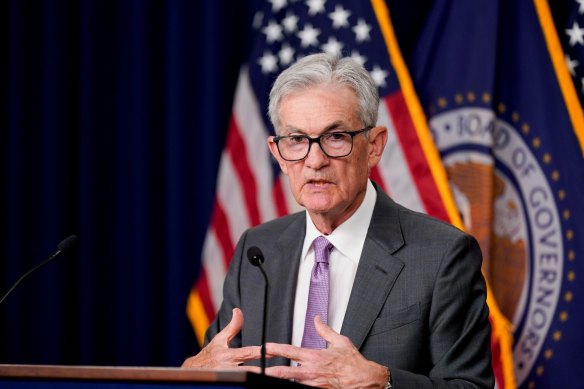This was published 6 months ago
Cut priced in: Markets eagerly wait for Fed’s view of the economy
If the United States Federal Reserve cuts interest rates in the world’s largest economy this week, as is largely anticipated, the real jolt to the Australian sharemarket will come not from what the Fed does, but what it says.
With annual inflation easing in the US, financial markets have priced in a 25 basis point cut to the cash rate at the Fed’s next meeting this week – the last before the November presidential election.

Australian investors are eagerly awaiting Fed chair Jerome Powell’s commentary on the state of the US economy. Credit: Bloomberg
Alphinity Investment Management principal Andrew Martin said Australian investors will be focused on the size of the cut and Fed chair Jerome Powell’s commentary on the US economy.
“There’s contention over whether it will be 25 or 50 basis points, and that might be a signal as to how aggressive the Fed wants to be and what they’re thinking about the economy,” Martin said.
“It’s not so much that they’re going to, but the message that comes with that cut. The commentary … and how aggressive they want to be, lay of the land, how the economy is panning, how they’re seeing inflation being in control.”
Inflation in the 12 months to August was 2.5 per cent, down from 2.9 per cent, marking the fifth consecutive annual drop. The bond market, which had flirted with the Fed cutting interest rates from its 5.25 per cent to 5.5 per cent range by 50 basis points, has now fully priced in a 0.25 percentage point drop.
ANZ is expecting the Fed to cut the cash rate by 200 basis points during this monetary easing cycle, but said the underlying financial and economic conditions did not warrant a more “forceful” first cut.
ANZ economists Brian Martin and Tom Kenny said while the July 2024 employment data showed the jobless rate rose to its highest level in three years, and triggered the famous recession indicator known as the Sahm rule, they did not believe the US economy would slow sharply any time soon.
“In the last three decades there have been three easing cycles that started off with a cut of more than 25 basis points,” Martin and Kenny said. “On each of these occasions (Black Monday October 1987, Dotcom bust January 2001 and the Global Financial Crisis September 2007), there was concern about a highly disruptive financial market event leading to a sharp recession. This is not a worry now.”
The pair said the rise in unemployment to 4.1 per cent in June reflected a slowdown in hiring rather than job layoffs, which remain near record lows.
Westpac chief economist Luci Ellis said the Fed’s rate cuts would have little impact on financial markets, which have already priced it in, nor the decision of the Reserve Bank of Australia, but it would affect the global economy.
“The world economy is looking soft at the moment,” Ellis said. “We have tight policy right around the world, and, importantly, China is looking a lot weaker than it was a little while ago. Commodity prices are lower, and that matters for [Australian] export prices, and global demand is likely to be softer than it perhaps has been in the immediate aftermath of the pandemic.”
Financial markets have fully priced in an RBA rate cut by Christmas, in defiance of governor Michele Bullock’s warning that interest rates would not fall this year because inflation is too high. Macquarie Group chief executive Shemara Wikramanayake on Friday said she did not expect the RBA to cut rates from its current level of 4.35 per cent until March next year.
The Market Recap newsletter is a wrap of the day’s trading. Get it each weekday afternoon.